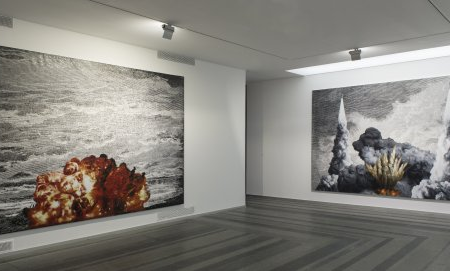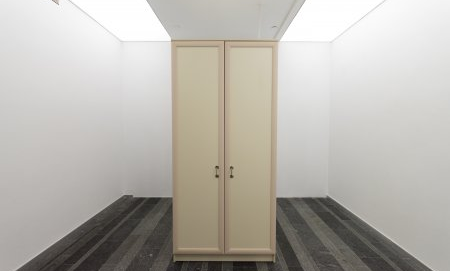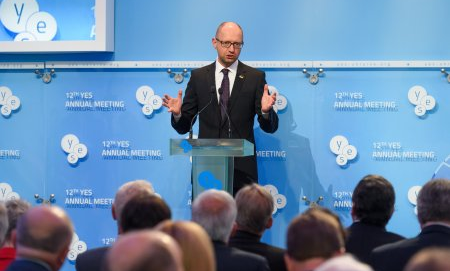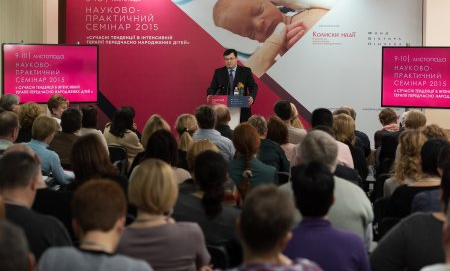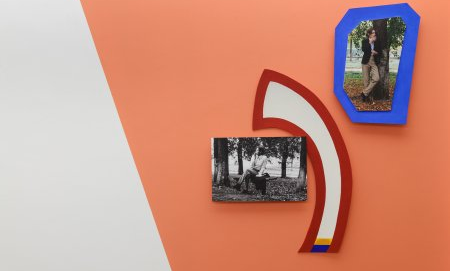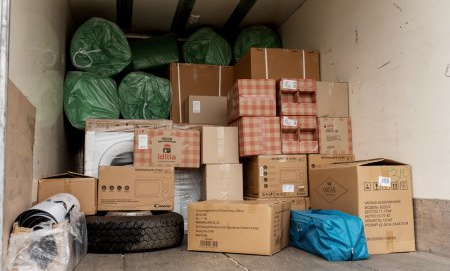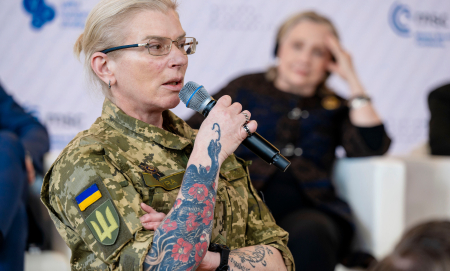News
“ART CAN TELL THE WORLD THINGS THAT CANNOT BE SHARED OTHERWISE”: Volodymyr Zelenskyy, the President of Ukraine addresses the Venice Biennale 2022 at the opening of THIS IS UKRAINE: DEFENDING FREEDOM @ VENICE 2022
The exhibition is presented by the PinchukArtCentre and Victor Pinchuk Foundation in partnership with the Office of the President of Ukraine and Ministry of Culture and Information Policy of Ukraine
VENICE, ITALY/ 21.04.22 - Scuola Grande della Misericordia in Venice. The PinchukArtCentre and Victor Pinchuk Foundation presented their official collateral event, This is Ukraine: Defending Freedom on 21st of April at the Scuola Grande della Misericordia in Venice. The official opening included the address of the President of Ukraine Volodymyr Zelenskyy where he said:
“It is unlikely there has ever been one year on planet Earth, when one nation hasn’t been fighting for their freedom. But there have been many years when most people took no notice of those fighting. This is what gives tyrants hope. Our people managed to draw attention to Ukraine’s fight for freedom, after Russia attacked us on February 24th. But this is not even half the job. Because then, you need to get people to support you for real; with weapons, financially, through political decisions, the constant flow of information. And you have to fight for such support, even though your defence of freedom depends also on the freedom of a dozen other nations in Europe and Asia.
This is what nourishes the hope of tyrants. Some nations, who live safely, are not ready to support immediately other free nations threatened by tyranny. To support their efforts as their own fight. This raises questions. Very important questions. If the entire democratic world has been built on the idea of freedom - then why do you often feel alone defending it? If freedom is a universal value, then why do other nations, who fight for freedom, not get equal support? What is it that separates us from each other at crucial moments? Politicians will not answer that. There are no experts who can explain this, and put it right. One will not find the answers in the media either. Because this is about something beyond words. One cannot express with words the feelings of a girl who is writing a letter to her dead mother in Mariupol, who died from Russian shelling a week before; the feelings of Ukrainian soldiers, who came to Bucha after the Russian occupiers were forced out, and saw hundreds of dead bodies simply lying on the ground. These feelings cannot be shown on television news. The feelings of medics in the street of Kharkiv, who were rescuing people wounded by Russian shelling, and got under even heavier shelling themselves - no platform in the world can express these feelings. The feeling of having lost your home, which now millions of Ukrainian men and women have, millions of internally displaced people – this feeling cannot be represented in an economic report. There are no tyrannies that would not try to limit art. Because they can see the power of art. Art can tell the world things that cannot be shared otherwise. It is art that conveys feelings. If you are free yourself, how can you understand other people who fight for their freedom? If you live in a country at peace, how will you empathise with those who can only dream of peace, and help them? How can you thank those who fought on their soil – for your freedom? Every single one of these questions is about art.
I want to thank everyone involved in organizing this project for the Venice Biennale. I am sure the exhibition will allow people to feel what it means for Ukraine to defend freedom. To feel the bond between all free people on planet Earth and Ukraine. To feel that each and every one of you can support the fight for freedom – one and the same freedom for everybody. Support us with your art, but also support us with your words and your influence…”
Victor Pinchuk, Ukrainian businessman and patron of the arts, added:
“War has different fronts, first of all, main military but also political, diplomatic, economical, informational and of the very important - cultural front. We decided that here in Venice during the main forum of art in the world we have to show how Ukraine fights for freedom. For us it is very important here to show Ukraine, for which values we are fighting, with contemporary art. But also it is very important to show how deep, how reach is our history, our culture. As a collector I know what inspires artists the most: love and tragedy. I know that war will inspire you, artists, maybe for centuries ahead but we don’t need your inspiration in hundred years. We need your inspiration now because you have capacity to inspire people, the decision makers who can save lives of Ukrainians, to send weapon to Ukraine now, today.”
Anastasiia Gulej, Holocaust survivor and Ukrainian refugee in Germany, commented:
“I recall the most terrible events in my life. The Holodomor of 1932-33. Every night we prepared things for my father in case they came for him just like they came for our school principal and took him away in the middle of class. No-one knows what happened to him. They must have shot him. We had just got over this fear and calmed down a bit when the war came on June 22, 1941. It was a very difficult time for us. Many prisoners of war died, they were starved to death and subjected to forced labour. Then there was the concentration camp, where we were transferred from Auschwitz so we wouldn't witness the Jews being driven in streams to the crematorium every day. It's called history, I wouldn't call it history – it is our yesterday. History is the Odyssey, it's the Trojan War, whereas all of this happened within the lifetime of one person. I would never have thought it could happen again in my life.”
The opening also held remarks from the Mayor of Venice, Luigi Brugnaro and president of the Venice Biennale Roberto Cicutto, alongside performances by singers Svyatoslav Vakarchuk and Tina Karol and a reading by Ukrainian ambassador in Italy Yaroslav Melnyk, from a letter by the First Lady, Olena Zelenska.
Across two chapters, the exhibition reasserts Ukraine’s cultural resilience that has always defined itself, even in the most challenging times, through its ability to think and create critically. Artists refuse direct war narratives and instead reflect deeply on their meaning, origin, and impact. This is Ukraine: Defending Freedom is about strength, it is about making, it is about friendship. But most of all, it is about our collective freedoms—the freedom to choose, the freedom to speak, and the freedom to exist.
The first chapter brings monumental and emotional works from three artists who continue to live and work in Ukraine during Russia’s war in Ukraine. The newly created pieces from Yevgenia Belorusets (1980), Nikita Kadan (1982), and Lesia Khomenko (1980) use the poetics of object evidence and the voice of witness to reflect on the realities of the war they bear witness to. The artworks are shown in dialogue with Ukrainian historical masterpieces, including works from Maria Priymachenko (Ukraine, 1909), Tetyana Yablonska (Ukraine, 1917), and an icon from Stefan Medytsky (Ukraine, 17th century).
The second chapter presents Ukrainian artists alongside international artist friends, they overview a deep connection to the country whilst forming a common front against the war. Their works respond to the urgent need for the global community to rally around Ukraine. These include Marina Abramović (Serbia, 1946), Olafur Eliasson (Denmark, 1967), JR (France, 1983), Damien Hirst (UK, 1965), Boris Mikhailov (Ukraine, 1938), and Takashi Murakami (Japan, 1962). The works on show are, on one hand, in direct response to the war, for example, Damien Hirst made new work for the exhibition, and the work by Murakami’s War and Peace (2015) was created directly in support of Ukraine after Russia’s 2014 annexation of Crimea and occupation of parts of Donetsk and Luhansk regions. On the other hand, works are chosen together with the artists as personal statements deeply rooted in the urgency to respond. For example, in the work of Marina Abramović, Count on Us (2003), Abramovic says: “Personally, for me, it is very difficult to make an immediate response in a situation of war. I need time to process, and I am always interested in creating something that is not just about the war at that moment but is transcendental and that has a message which can be used for wars anywhere at any time. I presented my installation Count on Us in 2003, and it was related to the Balkan War. Today, truth and freedom are under attack by Russia, and we all must stand up against it because this is a crime against the whole humanity.”
Finally, Volodymyr Zelenskyy, the President of Ukraine, also offers an image for the exhibition, a personal quote presented across the national flag reading, ‘We are defending our Freedom’.
Björn Geldhof, Curator of This is Ukraine: Defending Freedom and Artistic Director of the PinchukArtCentre, comments: “This is Ukraine: Defending Freedom is a joint force project between the PinchukArtCentre, the office of the President of Ukraine, and the Ministry of Culture. We conceptualised, prepared and installed the exhibition in less than four weeks, an impossible project for impossible times.
But doing the impossible is what Ukraine does on a daily basis. And for this reason, the exhibition is both necessary and urgent. Ukraine has a strong artistic voice, one that goes beyond direct war narratives but speaks, in the midst of it all critically, of life and survival, of love letters and dreams. We need this voice to be heard, we need to listen to it and rally around it.”
We are very grateful to our partners M9 and TBA21 for facilitating and supporting the loans of cultural heritage treasures from Ukraine in collaboration with the Ministry of Culture and Information Policy of Ukraine.
About the works
Nikita Kadan (1982, Ukraine) Difficulties of Profanation II (2015-2022) presents objects of war collected from Donbas in 2015 and Kyiv 2022. This is the second iteration of the work initially presented at the Ukrainian National pavilion in 2015. Now the work is open and expanding, as opposed to the previously closed vitrine, suggestive of healing; the wound is open, the war ongoing, the end unknown.
The first version of the work Difficulties of Profanation (2015) was created during the first year of the war Russia launched in Donbas. A traditional display case, its form referring to the Soviet-era display cases typically found in Ukrainian WWII museums, held materials that the artist collected in the then destroyed cities of eastern Ukraine. Among the debris, we can recognize familiar objects and words that are embedded with private memories, as well as with the historical past. These are smashed remnants of everyday lives. At the same time, damaged signs from Donbas bearing Soviet-era toponyms invite us to think about the geography of ideological narrative and its consequences. Amidst the rubble, inside the case, there was a bean plant growing, bringing hope for recovery.
In 2022 Nikita Kadan removed the display case and destroyed the garden. The open form of the work emphasizes the very nature of this war — unstopped and uncontrolled; a war that has expanded from the east of Ukraine to engulf the entire country. What was a “conflict” that had already moved to the periphery of the world's attention in 2015, has, in 2022, become a full-scale war. It becomes a monument to ongoing destruction, an expanding structure that is a frightening memento of the inevitable acceleration of Russian state violence.
A selection of archival images (postcards and photographs) are another added element. They refer to the Soviet narrative of the "Great Patriotic War", which is used in Russian propaganda to create "heroic" analogies that justify the brutal violence of the Russian military, but at the same time is based on the real experience of the Second World War, an experience that is shared by Ukraine.
Yevgenia Belorusets (1980, Ukraine) The war diary (February-April, 2022), presents texts and photos originally written in German for Der Spiegel magazine. Translated, edited and published by ISOLARII (Sebastian Clark and India Ennenga) with additional translations by Greg Nissan, designed by Office Ben Ganz, the diary was released daily on isolarii.com from February 24th, the first day of invasion, until April 4th.
Covering 40 days of war, Belorusets hoped each text would be the final entry. When the bombings started in Kyiv, Belorusets decided to stay, there in her home city, convinced the war would not last long. She wrote her first entry on February 24th. Each new entry was released online everyday at 4:00 pm EST. It’s a subjective account of the war, a witness statement, aimed to convey not what happens from above, but how it feels on the ground.
In 2018 Yevgenia released her book Lucky Breaks. It told private stories of women whose lives were affected by the war in Donbas (ongoing since 2014). Today she has become one of those women, a witness telling her own story from the heart of disaster.
Lesia Khomenko (1980, Ukraine) “Max in the army” series (2022) presents large-scale canvases reproduced from forbidden photographs taken by her husband. Four monumental paintings of volunteering soldiers: an IT-engineer, a chemist, a lawyer, and an artist.
While the photograph risks revealing too much information, it fails to touch reality all together. The real image of war cannot be expressed, a photograph remains a vague, accidental and partial impression of the real. Khomenko’s paintings expand the photograph, they include the impossibility of the image itself while making the protagonists larger than life. They are heroes to all Ukrainians, nameless and undepictable.
The starting point for the “Max in the army” series by Lesia Khomenko was a photo portrait of her husband, Max Robotov, made after he joined the army and she with her daughter evacuated Kyiv. “For me it was like teleporting my husband, an attempt to make him closer”, says the artist.nNow that Khomenko has established this teleportation channel between herself and the war, she keeps it open. She continues to depict her husband’s military comrades, using the pictures taken by him in the army. For Lesa, this collaboration is a way to be involved in her husband’s struggle, and also a way for the couple to maintain an artistic dialogue as they would have done previously, in spite of Max’s new military reality.
Working on this series Khomenko reflects on the role and status of the image, which in the context of war literally became a lethal weapon. Is it possible to disarm it through painting and transform it into something else — a love letter perhaps?
Maria Prymachenko (1909–1997, Ukraine) Boxers, 1977, Paper, gouache. Courtesy of The Andrey Sheptytsky National Museum in Lviv. Maria Prymachenko (1909–1997, Ukraine) Ancient wolf, 1977, Paper, gouache, Courtesy of The Andrey Sheptytsky National Museum in Lviv.
Maria Prymachenko was a self-taught Ukrainian artist, born in 1909 in the village of Bolotnya in Ivankiv Raion, Kyiv Oblast. She is well known for her surreal paintings of bizarre nonexistent beasts and plants that combined Ukrainian folk aesthetics and the artist’s unbridled imagination.
Her work is usually associated with naive art, yet in 1936 she studied in the Central Experimental Workshop of the Kyiv Museum of Ukrainian Art, where prominent Ukrainian avant-garde artists such as Anatil Petrytsky and Vasyl Krychevsky were then teaching. She achieved international recognition at the early stage of her career and has been actively exhibited worldwide. In 1937 she participated at the International Exhibition in Paris where her paintings received an enthusiastic review from Pablo Picasso. The United Nations Educational, Scientific and Cultural Organization (UNESCO) declared 2009 the year of Maria Prymachenko.
The works on display belong to the so-called “beast series”, featuring a collection of centaur-like creatures envisioned by the artist. Many of them paradoxically combine frightening monstrousness with fair, childlike features, charming but at the same time threatening. Some of Prymachenko's beasts, despite their surrealism, came into existence in response to historical and political events experienced by the artist, including the First and the Second World Wars.
Marina Abramović (1946, Serbia) Count on Us, Belgrade, 2003. Four-channel video installation (color, sound). 12 minutes. Courtesy of the Marina Abramović Archives
The work Count on Us was created by Marina Abramović in response to the Balkan Wars, known for their cruelty and the great number of civilian casualties. A similar barbarism has shocked the world again, this time committed by Russian soldiers against the peaceful Ukrainian residents of Bucha, Irpin and other cities that have temporarily fallen under occupation.
Count on Us is a heartbreaking warning that crimes against humanity must be decisively fought with the solidarity and united efforts of all humanity. If we do not resist, the evil will expand and the horror will be repeated. At the same time, the work is a declaration of hope, and of a desire to live and love that cannot be destroyed. Acts of genocide are now repeating in Ukraine, and the world is once again called to unite against them.
Boris Mikhailov (born 1938, Ukraine) from “Temptation of Death” series (2017-2019), C-print.
Temptation of Death are visual poems where Boris Mikhailov stares his own life—and the past of the Soviet Union—in the eye. The work embraces the artist’s own mortality together with the demise of the Soviet past.
Temptation of Death is an extensive photographic series that consists of more than 150 pairings, where the artist’s distinct autobiographical tune is inseparable from a bleak social premonition. The formal diptych structure evokes strong feelings of the ambiguity and paradox of human life, where the most beautiful and the most terrifying things are incomprehensibly entangled.
Olafur Eliasson (1967, Denmark) Your Lost Lighthouse (2020). Lighthouse lens (dated ca.1900), colour-effect filter cylinder, halogen light bulb, fluorescent light, brass, steel, ballast. Courtesy of the artist; Tanya Bonakdar Gallery, New York / Los Angeles; neugerriemschneider, Berlin © 2020 Olafur Eliasson
The SOS signal of Your Lost Lighthouse cannot be more current. Although it uses an antique lighthouse lens dated circa 1900, the beacon no longer functions as a reliable guide in the darkness, saving people’s lives at sea. It now stands as a symbol of ongoing war, an emergency that cannot be avoided but must be stopped.
Project by zn.ua (Mirror of the Week). "Mothers" series (2019). Photographers: Hanna Hrabarska, Hanna Zolotniuk, Oksana Kanivets, Yevhenii Kershkov, Maxym Kozmenko, Oleksandr Kornyakov, Inna Liudvyk, Anton Malynovskyi, Valeriy Miloserdov, Mustafa Nayyem, Viktor Stadnyk, Oleksandr Techynskyi. Courtesy Mirror Weekly
"Mothers" series (2019) presents 300 portraits of mothers who lost a son in the Russo-Ukrainian War on the Donetsk and Luhansk fronts in the period from 2014-2015. These photographs are a reminder of when the war started, and a tribute to young soldiers who died defending their land. Each portrait is signed with the name of the mother and her son, along with his age and a pet name she used to call him as a child.
Russian propaganda has actively sought to demonize the Ukrainian military, calling them “Nazis” because they came to the defense of their own land. As the events of 2022 have shown, Russian propaganda has successfully dehumanized Ukrainians in the eyes of the Russian people—soldiers and civilians alike—paving the way for the ongoing invasion.
Before the Russian invasion on February 24th, 2022, over 14,000 people had lost their lives in a war that was already nearly forgotten in the West. Today the death toll is unknown. While Russia refuses to officially recognise many of its fallen soldiers, hiding their deaths from their families, the mothers of fallen Ukrainians know, and they speak.
Takashi Murakami (1962, Japan) Ukraine: War and Peace (2018) Acrylic, platinum leaf and gold leaf on canvas mounted on aluminum frame. Courtesy PinchukArtCentre (Kyiv, Ukraine)
Takashi Murakami created “War and Peace” in 2015 in response to the annexation of Crimea and the occupation of parts of Donetsk and Luhansk regions. Today this becomes an iconic image for Ukraine: a country fighting for its very existence, fighting for peace, fighting for the right to exist.
Today this title, a reference to the world-famous novel by Russian writer Leo Tolstoy, becomes a complication for a work dedicated to Ukraine under Russian attack. Can we read Ukrainian history through the cultural lens of an aggressor country? Here it becomes a provocative gesture, inviting us to think more carefully about the relationship between culture, politics, and violence.
JR (1983, France) Valeriia (2022)
Five-year-old Valeriia, a Ukrainian refugee from Kryvyi Rih, is one of more than four million Ukrainian children who have been forced to flee their homes to survive.
The monumental tarp, depicting Valeriia, was unfolded in an action in Lviv as a tragic reference to the deliberate bombing of the Mariupol Drama Theater by Russian aircraft. For this dynamic work, JR recruited more than 100 Lviv volunteers. The image reached Time magazine and the action extended across different parts of the world, most recently on the 13th of April on the Piazza San Marco in Venice.
Uncountable children have died in Russia's vile and ruthless war against Ukrainian cities, neighborhoods, orphanages, hospitals, kindergartens, maternity hospitals and shelters.
Tetyana Yablonska (1917–2005, Ukraine) Youth (1969) Oil on canvas. Courtesy National Art Museum of Ukraine
For artists who lived under the Soviet Union, the depiction of nature was often a door to escape from the oppressive social environment and obligatory ideological narratives. Tetyana Yablonska’s painting “Youth” is like a dream or a fantasy about another reality, where the hero looks into the bottomless blue of a small lake as if into a future full of hope and the thrill of the unknown.
Although socialist realism was the only style authorized for Soviet artists, many of them invented individual ways to overcome its limitations. Tatyana Yablonska was a professor and a full member of the Academy of Arts of the USSR, as well as a recipient of numerous state awards and honored as People's Artist of the USSR. Few artists were as respected and privileged by the Soviet government. At the same time, she was able to create her own unique visual world, full of vibrant light and crisp air, which transcended any ideological agenda. The narrative of “Youth” is abstract and poetic, and the style and color of the painting create a surreal sense. The bare, otherworldly landscape is a realm of potentiality, where nothing is decided yet and everything is possible.
Stefan Medytsky (?–1689, Ukraine) Intercession of the Blessed Virgin, as a variation on All Sorrow Joy, Second half of the 17th century. Courtesy The Andrey Sheptytsky National Museum in Lviv
The Mother of God holds the episcopal omophorion in her hands, protecting the faithful. This iconography is unique to the Eastern Christian tradition, yet has similarities with the Western Christian story of the Madonna of Mercy. The cult of the protective icon established itself in the Ukrainian icon-painting tradition from the 12th to the 13th century.
The cult of the Intercession of the Virgin in art and culture was most vividly embodied during the Cossack period. The Virgin was considered the heavenly patron saint of the Cossack army, and even the consecration of the church of the Zaporizhzhian Sich was timed to the holiday of the Intercession of the Virgin. Since then, the sacred image of Our Lady of the Intercession has been a symbol of the Ukrainian army. Today it has once again risen to prominence in Ukrainian visual culture.
Over the centuries, the interpretation of sacred images has become increasingly diverse, transformed into visual archetypes, which are read both in terms of their original religious significance and in the context of recent historical processes.
As such, in this crowd of believers we can see today’s tragic footage of the evacuation of Irpin, a city attacked near Kyiv. The people of Irpin hid from shelling under the ruins of a destroyed bridge. And, in the omophorion that the Mother of God uses to protect the faithful, we now see the protective dome of the No Fly Zone that Ukrainians are begging the international community to provide.
Damien Hirst (1965, UK) Wretched War (2005) Bronze. Edition of 10. Private Collection © Damien Hirst and Science Ltd. All rights reserved, DACS 2022.
Some historical moments provoke head-on responses. Damien Hirst’s Wretched War is one such response. The war crimes of Bucha lay fresh in our collective memory, even as we recognize that they are only the tip of the iceberg. And yet, beyond all violence, the posture of the victim’s body expresses unexpected strength and confidence.
The figure’s pose is borrowed by the artist from a sculpture by the Impressionist Edgar Degas — his famous Study in the Nude for The Little Fourteen-Year-Old Dancer (circa 1880). Despite missing her head in Hirst version, the dancer continues to stand firmly on her sterling silver feet, like some immortal and undefeatable creature from a science fiction film.
Damien Hirst (1965, UK) Sky Over Corn Field, 2022, Butterflies and household gloss on canvas. Private Collection © Damien Hirst and Science Ltd. All rights reserved, DACS 2022.
Sky Over Corn Field was created in solidarity with Ukraine, in direct response to Russia’s violent and unprovoked invasion. The butterflies embody both tragedy and hope, speaking equally to both mortality and immortality.
Hirst explains that his obsession with butterflies stems from the idea that even when butterflies are dead, they appear alive. The metaphor of the butterfly holds special significance in numerous mythologies, representing spiritual rebirth, transformation, change, hope, and life.
Facebook, Instagram, Youtube, Artsy
#ThisIsUkraine #ThisIsUkraineDefendingFreedom
Location: Scuola Grande della Misericordia, Sestiere Cannaregio, 3599, 30121 Venice, Italy
Opening Period: 23rd of April till 7th of August 2022
Opening hours: 10 am – 6 pm every day except Mondays
Preview Days: 20th and 22nd of April, 10 am – 6 pm,
Commissioned and promoted by the Victor Pinchuk Foundation
Organized by the PinchukArtCentre, Kyiv, Ukraine
Curated by Björn Geldhof













